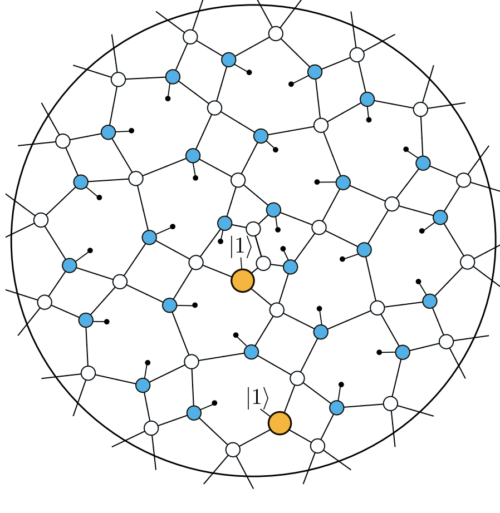Sculpting nature

A schematic of a quantum circuit used to study quantum gravity. A one-dimensional magnet enters the circuit at the circle’s circumference and a model of gravity is produced at the black dots. The blue, white, and yellow circles represent the quantum gates making up the circuit. (Image: Rahul Sahay, Mikhail D. Lukin, Jordan Cotler, arXiv:2401.13595.)
When Harvard University Ph.D. candidate Rahul Sahay was in high school, he watched a documentary on quantum mechanics and became fascinated by the bizarre universe it suggested. He took a lot of math and physics classes, falling in love with the process of translating abstract ideas into simple physical pictures and pictures into ideas. By the time he finished high school, he was dead set on physics.
After graduating from the University of California, Berkeley (see sidebar, “Quantum roots”), he began his Ph.D. work in 2021 with Ashvin Vishwanath. Now in his fourth year at Harvard, he aims to understand different phases of matter and how to create them in modern experiments. His hope is that we can learn how to create phases that could be useful in quantum computers or in other technologies.
Sahay probes the inner workings of quantum systems through both pen-and-paper calculations and computer simulations. At subatomic levels, particles show seemingly bizarre quantum behavior, which directly depends on whether and how such particles are observed. For example, a particle’s position and its velocity cannot be determined simultaneously, and a particle can exist in multiple states — like Schrödinger’s famous cat that is both alive and dead — until it is observed. Sahay acknowledges that scientists do not understand many aspects of this process, but they are getting better at describing the mathematics behind it.
One idea Sahay has recently explored for creating new matter phases is to use quantum measurement — the process that describes how a quantum system is changed when observed.
Although quantum measurement is typically used to study a system, Sahay showed that researchers can use this technique to alter matter’s form on purpose. This idea could allow scientists to manipulate atoms into quantum spin liquids and other unusual arrangements that depend on delicate, distant connections such as entanglement. Sahay characterized possible states of matter that could be created.
“By looking at something in kind of intricate ways,” he says, “you can shape it. You can make it into something more exotic than it started off being. And that’s one of the weird properties of quantum mechanics.”
The Department of Energy Computational Science Graduate Fellowship provided the flexibility to collaborate extensively with researchers in Harvard’s physics department and beyond, creating partnerships encouraged by his advisor Vishwanath.
He had an inspiring practicum at Argonne National Laboratory with Ivar Martin. The first inklings of his recent paper on using quantum measurement to create new states of matter occurred to him during his time at the lab.
He’s also recently published research on quantum gravity. Gravity, he says, governs large things; quantum mechanics go small. “Getting them to play nicely with one another is challenging.”
To unravel the big-meets-small puzzle, he developed a minimal theoretical model describing a lot of particles interacting with each other, a so-called many-body system, whose collective behavior is described by quantum gravity. Crucially, the model prescribes a recipe for investigating quantum gravity in a quantum computer. Instead of using the binary 0-or-1 bit system of classic computers, quantum computers operate at a smaller scale and work with qubits, which hold not just 0s or 1s, but the probability that the qubit will collapse into either a 0 or a 1 when observed.
Because qubits have quantum behavior, the theory describing them can serve as a model system for the quantum theory of gravity. Sahay figured out how the qubits needed to interact so that if you examine them from far away, they simulate how space and time bend under the influence of gravity.
His work is theoretical, but it’s rooted in things that are technologically possible, including developing and assessing the limits of experimental protocols, he says. His results point to recipes that scientists can follow with off-the-shelf technology.
Besides following up on his papers about measurement and gravity, he’s working on how to make quantum computers more resilient. Quantum computers are fragile; a puff of air can collapse the whole system.
He hopes to become a physics professor, continuing to work in the interdisciplinary space between many-body physics and quantum information science.
About the Author
The author is a science writer and journalist based in New York City.





You must be logged in to post a comment.